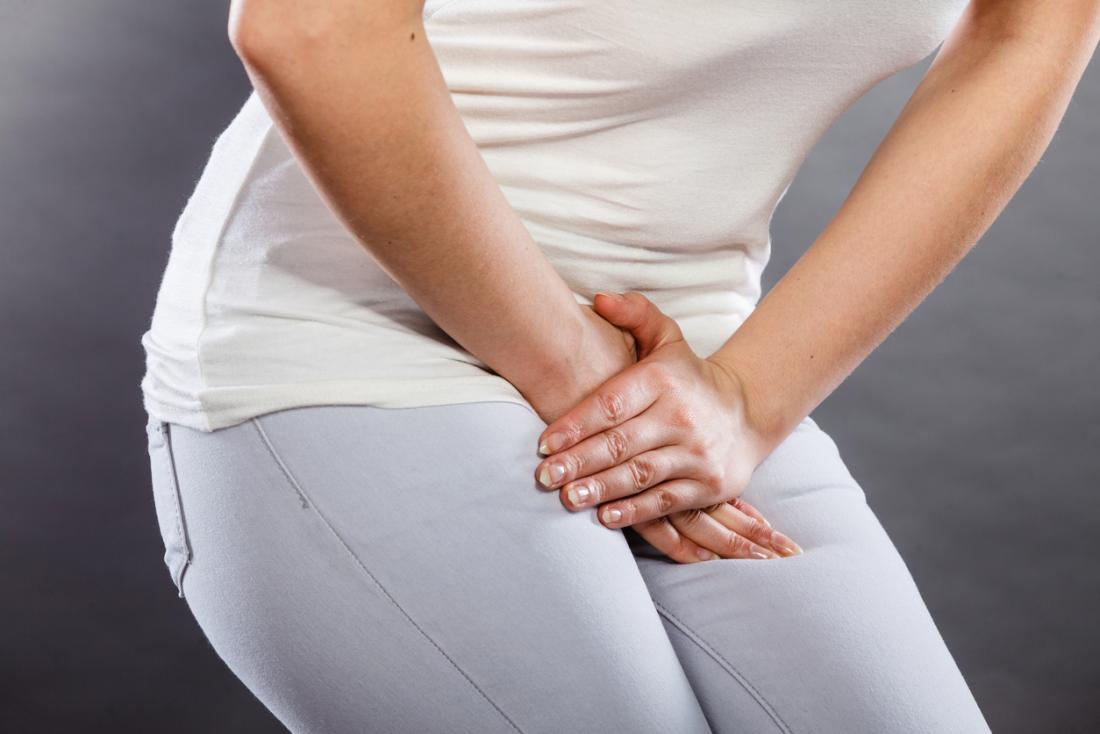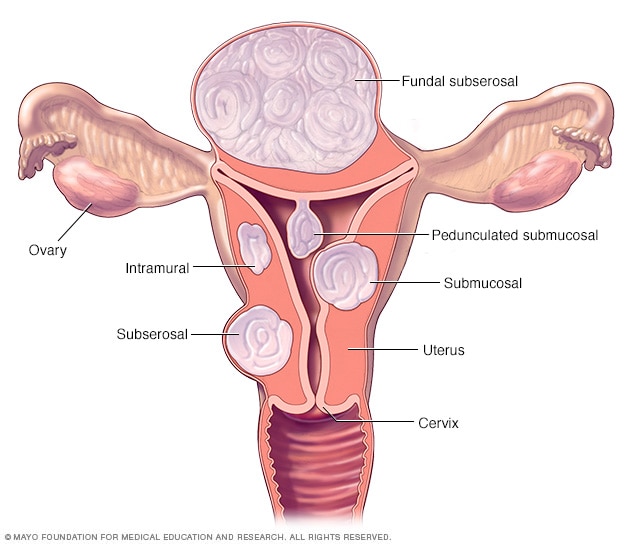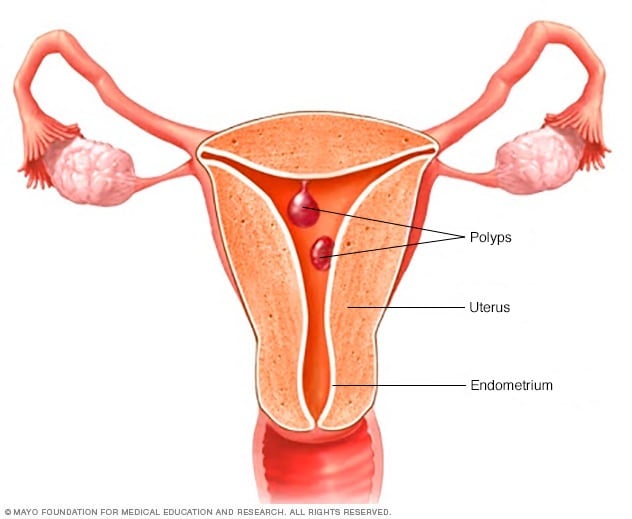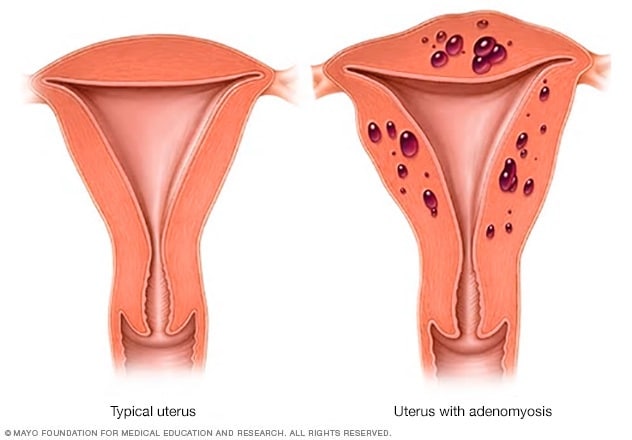
With menorrhagia, you can’t maintain your usual activities when you have your period because you have so much blood loss and cramping. If you dread your period because you have such heavy menstrual bleeding, talk with your doctor. There are many effective treatments for menorrhagia.
Menorrhagia is the medical term for menstrual periods with abnormally heavy or prolonged bleeding. Although heavy menstrual bleeding is a common concern, most women don’t experience blood loss severe enough to be defined as menorrhagia.
Symptoms
Signs and symptoms of menorrhagia may include:
- Soaking through one or more sanitary pads or tampons every hour for several consecutive hours
- Needing to use double sanitary protection to control your menstrual flow
- Needing to wake up to change sanitary protection during the night
- Bleeding for longer than a week
- Passing blood clots larger than a quarter
- Restricting daily activities due to heavy menstrual flow
- Symptoms of anemia, such as tiredness, fatigue or shortness of breath
Causes
In some cases, the cause of heavy menstrual bleeding is unknown, but a number of conditions may cause menorrhagia. Common causes include:
- Hormone imbalance. In a normal menstrual cycle, a balance between the hormones estrogen and progesterone regulates the buildup of the lining of the uterus (endometrium), which is shed during menstruation. If a hormone imbalance occurs, the endometrium develops in excess and eventually sheds by way of heavy menstrual bleeding.
A number of conditions can cause hormone imbalances, including polycystic ovary syndrome (PCOS), obesity, insulin resistance and thyroid problems.
- Dysfunction of the ovaries. If your ovaries don’t release an egg (ovulate) during a menstrual cycle (anovulation), your body doesn’t produce the hormone progesterone, as it would during a normal menstrual cycle. This leads to hormone imbalance and may result in menorrhagia.
- Uterine fibroids. These noncancerous (benign) tumors of the uterus appear during your childbearing years. Uterine fibroids may cause heavier than normal or prolonged menstrual bleeding.
- Polyps. Small, benign growths on the lining of the uterus (uterine polyps) may cause heavy or prolonged menstrual bleeding.
- Adenomyosis. This condition occurs when glands from the endometrium become embedded in the uterine muscle, often causing heavy bleeding and painful periods.
- Intrauterine device (IUD). Menorrhagia is a well-known side effect of using a nonhormonal intrauterine device for birth control. Your doctor will help you plan for alternative management options.
- Pregnancy complications. A single, heavy, late period may be due to a miscarriage. Another cause of heavy bleeding during pregnancy includes an unusual location of the placenta, such as a low-lying placenta or placenta previa.
- Cancer. Uterine cancer and cervical cancer can cause excessive menstrual bleeding, especially if you are postmenopausal or have had an abnormal Pap test in the past.
- Inherited bleeding disorders. Some bleeding disorders — such as von Willebrand’s disease, a condition in which an important blood-clotting factor is deficient or impaired — can cause abnormal menstrual bleeding.
- Medications. Certain medications, including anti-inflammatory medications, hormonal medications such as estrogen and progestins, and anticoagulants such as warfarin (Coumadin, Jantoven) or enoxaparin (Lovenox), can contribute to heavy or prolonged menstrual bleeding.
- Other medical conditions. A number of other medical conditions, including liver or kidney disease, may be associated with menorrhagia.
Risk factors
Risk factors vary with age and whether you have other medical conditions that may explain your menorrhagia. In a normal cycle, the release of an egg from the ovaries stimulates the body’s production of progesterone, the female hormone most responsible for keeping periods regular. When no egg is released, insufficient progesterone can cause heavy menstrual bleeding.
Menorrhagia in adolescent girls is typically due to anovulation. Adolescent girls are especially prone to anovulatory cycles in the first year after their first menstrual period (menarche).
Menorrhagia in older reproductive-age women is typically due to uterine pathology, including fibroids, polyps and adenomyosis. However, other problems, such as uterine cancer, bleeding disorders, medication side effects and liver or kidney disease must be ruled out.
Complications
Excessive or prolonged menstrual bleeding can lead to other medical conditions, including:
- Anemia. Menorrhagia can cause blood loss anemia by reducing the number of circulating red blood cells. The number of circulating red blood cells is measured by hemoglobin, a protein that enables red blood cells to carry oxygen to tissues.
Iron deficiency anemia occurs as your body attempts to make up for the lost red blood cells by using your iron stores to make more hemoglobin, which can then carry oxygen on red blood cells. Menorrhagia may decrease iron levels enough to increase the risk of iron deficiency anemia.
Signs and symptoms include pale skin, weakness and fatigue. Although diet plays a role in iron deficiency anemia, the problem is complicated by heavy menstrual periods.
- Severe pain. Along with heavy menstrual bleeding, you might have painful menstrual cramps (dysmenorrhea). Sometimes the cramps associated with menorrhagia are severe enough to require medical evaluation.
- Ferri FF. Menorrhagia. In: Ferri’s Clinical Advisor 2017. Philadelphia, Pa.: Elsevier; 2017. https://www.clinicalkey.com. Accessed April 10, 2017.
- Heavy menstrual bleeding. Centers for Disease Control and Prevention. https://www.cdc.gov/ncbddd/blooddisorders/women/menorrhagia.html. Accessed April 13, 2017.
- Frequently asked questions. Gynecologic problems FAQ095. Abnormal uterine bleeding. American College of Obstetricians and Gynecologists. http://www.acog.org/Patients/FAQs/Abnormal-Uterine-Bleeding. Accessed April. 13, 2017.
- Cunningham FG, et al. Abnormal uterine bleeding. In: Williams Obstetrics. 24th ed. New York, N.Y.: The McGraw-Hill Companies; 2014. http://accessmedicine.mhmedical.com. Accessed April 10, 2017.
- AskMayoExpert. Adolescent menorrhagia. Rochester, Minn.: Mayo Foundation for Medical Education and Research; 2016.
- Kaunitz AM. Approach to abnormal uterine bleeding in nonpregnant reproductive-age women. https://www.uptodate.com/home. Accessed April 13, 2017.
- Kaunitz AM. Management of abnormal uterine bleeding. https://www.uptodate.com/home. Accessed April 13, 2017.
- MR-guided focused ultrasound for uterine fibroids. Radiological Society of North America. https://www.radiologyinfo.org/en/info.cfm?pg=mrgfus. Accessed April 15, 2017.
- Butler Tobah YS (expert opinion). Mayo Clinic, Rochester, Minn. May 18, 2017.



